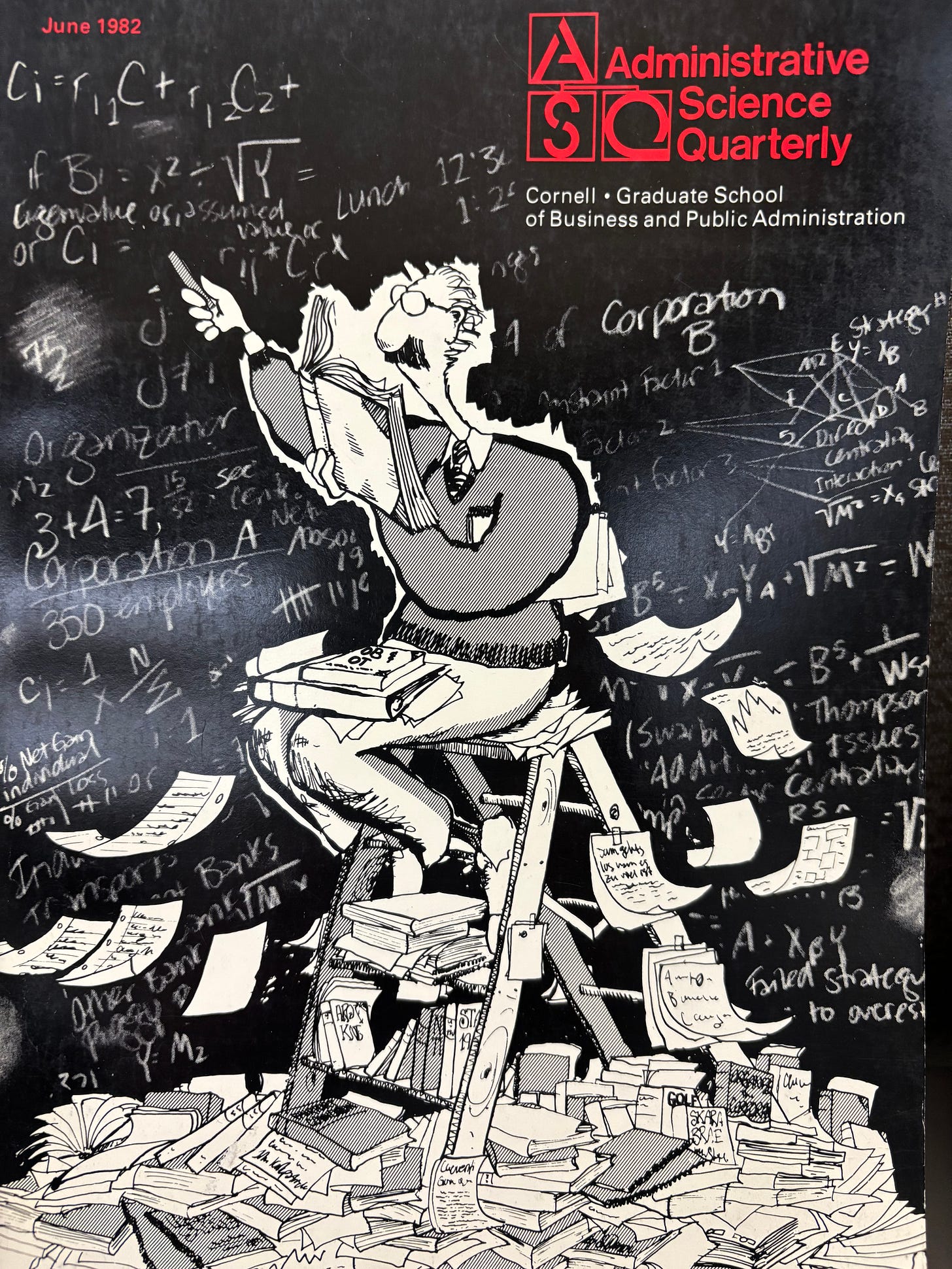Announcing our new editor, the value of curation, and writing and reviewing guidance
Beth Bechky joins as our new editor, Christine Beckman and András Tilcsik reflect on the value of curation, and Ashleigh Imus tells us why there is no one best way to write
Announcing our new Editor
We are thrilled to announce that Beth Bechky has been selected as the next editor of Administrative Science Quarterly.
Beth is an ethnographer of work and occupations, focusing on how workers collaborate and manage the challenges of technological change. Importantly, Beth brings extensive editorial experience to this role. She has been a valued associate editor with ASQ since 2021, and she previously served as a senior editor at Organization Science. As a scholar examining the intersection of work and technology, Beth is well-positioned to help ASQ navigate the evolving landscape of academic publishing.
Beth completed her undergraduate degree at the School of Industrial and Labor Relations at Cornell University, which happens to be the same institution that owns ASQ. It is wonderfully fitting to have her as the next editor of the journal.
Please join us in congratulating Beth on this selection and thanking her for taking on such an important and demanding role for the field and for the journal. She will begin her term on July 1, 2025. As Editor, Beth will continue to handle manuscripts, but the process has begun to replace Christine and András
We also offer our deepest thanks to the search committee for their efforts: Ann Langley (chair), Justin Berg, Lisa Cohen, Trish Reay, and Anne ter Wal. After careful deliberation, they recommended Beth to Cornell's ASQ Advisory Council. Our field is very fortunate that they approved the nomination and that Beth agreed to take the helm.
Academic Values and ASQ: Curating
By Christine Beckman (Editor) and András Tilcsik (Deputy Editor)
With ASQ publishing its 70th volume in 2025, this is an opportune moment to revisit the question of what journals are for—and ASQ’s role in particular (Daft, 1980; Davis, 2014; Palmer, 2006). Journals are a vital part of a larger ecosystem, and it’s worth reminding ourselves of the academic values they uphold and why they matter. These values are our raison d’etre and yet all too easy to forget in the rush of daily obligations, the narrow incentive structures of our institutions, and the hustle of getting ahead. A crucial function of journals is to manage the overwhelming amount of information available and to help focus our attention on what is worth reading. Journals serve this larger purpose as they help to curate, cultivate, certify, and convene (Davis, 2014; see also Rallison, 2015).
The first sentence ever printed in ASQ appeared in the editorial essay of its inaugural issue in 1956: “Science has been compared to pursuit of the horizon; each step forward reveals more to be taken.” That same issue featured an essay by the journal’s founding editor, James D. Thompson (1956: 111), who observed that “answers to questions of administration are more likely to come by increment than by the master stroke of one research project, and this requires a research sequence with each piece building on the knowledge gained before.” These words capture the essence of ASQ’s role: ensuring that each contribution builds on and advances what came before.
Upholding this vision requires ASQ to curate and certify important scholarship, cultivate rigorous research practices, and convene a community of researchers.
How does ASQ accomplish this?
In this month’s newsletter, we focus on the importance of curation. If you want to know the current thinking of your field, there are a small subset of journals whose tables of contents you (virtually) peruse. This is not to say that there aren’t other mediums with important insights and perspectives. But in a sea of sources, the curating of scholarship gives us confidence in what we read and helps streamline our attention. Other models to the traditional journal follow the wisdom of crowds approach instead. Outlets like SSRN publish papers without a review process and let the academic community determine what will rise to the top. Yet many scholars already have a hard time keeping up with the curated research in their fields. Furthermore, many common metrics of quality (such as citations) can be artificially boosted with new tools and methods, weakening the value of these signals (Bechky and Davis, 2025; Burton-Jones and Wang, 2023). It is possible for scholars to ensure they have a breadth of knowledge by reading a variety of editorially curated journals and sources.
Arguably, one of the most important roles of ASQ is to curate articles and offer a select number of them each year that are well-written, theoretically important, and empirically rigorous. We strive to get a broad array of scholars reading each article when they receive our table of contents alerts. For a journal that covers so many theoretical areas, we know this can be challenging. But ASQ articles are the best of the best. We do not say this lightly. Weighted by our small number of publications, ASQ “stands alone” by appearing on more doctoral syllabi than any other organizational journal (Colquitt, Long, and Gentry, 2024: 21). Both the OMT and OB Divisions of the Academy of Management have frequently selected ASQ articles as the best published papers of the year (including during our editorial term). ASQ is also well represented among the recent winners of the American Sociological Association’s W. Richard Scott Award and the Responsible Research in Business and Management (RRBM) awards.
Because ASQ publishes such a wide range of papers, we also curate virtual special issues in which we bring together previously published articles on a particular topic. In the last few years, we have curated an issue in honor of Women’s History Month, one on healthcare organizations, and one highlighting the RRBM award winners. For each virtual special issue, we ask leading scholars in the field to curate it and write an introduction offering reflections on that area of research. In 2023, we curated a joint virtual special issue on technology and institutions in conjunction with MISQ to highlight the interdisciplinary nature of ASQ scholarship; the two journals then co-hosted an online symposium with authors featured in that issue, which brought together hundreds of participants. Technology is not a replacement for human interaction, but this was the first ASQ virtual special issue to leverage our post-pandemic comfort with online forums to connect with scholars across the globe.
In addition to curating articles and collections of articles, we also have a robust queue of book reviews that highlight a wide range of organizational research. Some of the books we review are written by existing members of the ASQ community of organization scholars, but the goal of the book review program includes exposing ASQ readers to authors and topics that are broadly relevant to organizational scholars. These book reviews span a fascinatingly diverse range of topics: indigenous economic relationships and global business strategy, machine learning and ethnography, Mao Zedong and Milton Friedman, visual art and cancer therapeutics, air traffic controllers and social media influencers, Palestinian workers in Israel and queer careers in post-war America. We want organizational scholars to think broadly and read widely.
In next month’s newsletter, we will discuss the role of journals in cultivating papers.
Bechky, B. A., and G. F. Davis
2025. “Resisting the algorithmic management of science: Craft and community after generative AI.” Administrative Science Quarterly, 70(1): 1–22.
Burton-Jones, A., and G. Wang
2023. “What makes a journal significant? From the tyranny of metrics to true impact.” MIS Quarterly, 47(2): i–xiv.
Colquitt, J. A., D. M. Long, and R. J. Gentry
2024. “Syllabus share: A new metric for gauging journal status.” Journal of Management Education, 48(1): 7–51.
Daft, R. L.
1980. “The evolution of organization analysis in ASQ, 1959–1979.” Administrative Science Quarterly, 25(4): 623–636.
Davis, G. F.
2014. “Editorial essay: Why do we still have journals?” Administrative Science Quarterly, 59(2): 193–201.
Palmer, D.
2006. “Taking stock of the criteria we use to evaluate one another’s work: ASQ 50 years out.” Administrative Science Quarterly, 51(4): 535–559.
Rallison, S. P.
2015. “What are journals for?” The Annals of The Royal College of Surgeons of England, 97(2): 89–91.
Thompson, J. D.
1956. “On building an administrative science.” Administrative Science Quarterly, 1: 102–111.
✍️ Ashleigh´s Writing Corner ✍️
Young People and The Ingenious Freedom of Language: Why There’s No One Best Way to Write
By Ashleigh Imus (Associate Managing Editor)
I recently learned that the verbs “eat” and “cook” don’t always require a direct object—if you’re a teenager in the U.S., that is. My teenage daughter and her friends like to toss around phrases like “that fit ate!” (somebody is wearing a cool outfit), or “UConn cooked in that game!” (UConn women’s basketball won the national championship by a large margin).
Young people’s vibrant linguistic creativity can teach us much about how to write better—as well as how to effectively undermine controlling adults, governments, and other nefarious groups. Just when we’re sure of a so-called rule of language usage, a new and often rebellious construction emerges—often from a young population.
This constant evolution is fascinating because it means there is always more to learn about language and writing. I was reminded of this recently when yet another great ASQ book review came across my desk: Summer Jackson’s review of The Black Ceiling: How Race Still Matters in the Elite Workplace, by Kevin Woodson.
Jackson’s excellent writing in this review reminded me that there really is no one best way to write. A couple of months ago in this newsletter, I wrote about the value of alternating sentence length to create a more interesting reading experience and to pace one’s ideas. In her book review, Jackson shows that is not the only way to write well. Her style mostly favors relatively long sentences. She specializes in relative clauses, and in her expert hands this periodic style is a pleasure to read, in part because it creates suspense. Take a look at this sentence, which recounts Woodson’s description of how stigma anxiety can lead Black professionals to engage in “racial risk management behaviors” (p. 1):
Importantly, Woodson notes that it only takes the mere (perceived) threat of racial discrimination to provoke these behaviors, which, while understandably aimed at protecting the individual from possible mistreatment, ironically lead to further alienation, marginalization, and vigilance. (p. 1‒2)
This complex sentence works so well because the writer has total control over the structure (or syntax, which can be thought of as the traffic rules of language). Jackson begins with a main clause and then introduces “which” to begin a relative clause, e.g., “which . . . ironically lead to further alienation . . . “ But before she completes that relative clause, she introduces a phrase that, like the relative clause, also modifies “behaviors.” This is the participial phrase beginning with “while understandably aimed . . .” Besides the excellent management of syntax, these structures also work because the form reinforces the content: Here and throughout the review, Jackson uses sentences with frequent and sometimes complex internal phrases and clauses to convey the complexity of Black professionals’ experience in majority-White elite workplaces.
Here's another example—one that might seem controversial from the point of view of syntax:
[Woodson’s] ability to define, describe, and illuminate the byzantine journey that Black professionals face in elite institutions will not only resonate with other Black professionals but will also shed much-needed light and nuance on the challenges that these professionals—who possess the skills, knowledge, and ability to succeed in the workplace—face. (p. 3)
At first glance, the sentence almost seems tautological or at least redundant, with its near-repetition of the phrase “that Black professionals face” first at the beginning and again at the end of the sentence (“the challenges that these professionals . . . face”). But I left it as is because it makes sense. The first instance describes Black professionals’ journey, while the second describes their challenges. The replication of “face,” especially its second appearance as the final verb, hits like a hammer, insisting that we pay attention to just how much Black professionals have to confront in elite workplaces. The relative clause beginning “who possess the skills . . .” interrupts the subject and the verb, forcing readers to notice the stark contrast between what Black professionals deserve and what they actually receive.
This kind of writing is hard to get right. Along with Jackson’s creative, precise word choices (e.g., “deft,” “converge,” “byzantine”), her syntactic skill implies a writer who reads extensively. She teaches by example that if we want to write well, we also need to read—and not just for work.
Of course, there is a world of difference between teenage slang and Jackson’s polished prose and scholarly expertise. But her writing also reminds us to value what young people know, particularly given the current authoritarian attempts in the U.S. to wipe out language and concepts that reflect the diverse truths of life and language. We should always pay attention to what senior scholars and editors can teach us about writing. But especially now, when we need urgent reminders of how ingenious, insistent, and rebellious the human capacity for freedom and language can be, we should also listen to young people.
AI-RELATED GUIDANCE FOR ASQ REVIEWERS
ASQ follows Sage’s AI policy for authors, reviewers, and editors.
Can I use an AI-supported tool to help me write my review?
You may use AI tools only to improve the language of your review. You may not use AI to write your review. You may not feed any portion of the submission into any AI tool because of confidentiality and copyright issues. Never feed another scholar’s unpublished work into a tool that could use that content in its future outputs to other users.
If you feed your review into an AI tool to improve the review’s language and structure, you must read the output carefully before you submit it; you are responsible for what the tool creates. If an AI tool introduces errors, you must catch and correct them. For example, AI tools are known to create fake citations or references based on scholars’ names you might include in your review text.
If an ASQ editor believes that you have used AI to create any portion of your review, we reserve the right not to use your review and to ask you for an explanation. Depending on your response, we also reserve the right to mark you as an ineligible reviewer in our ScholarOne system.
If an author states that they have used AI when creating any part of their submission, should I consider that a red flag and immediately recommend rejection?
No. ASQ will assess authors’ use of AI on a case-by-case basis. We believe that many authors are already using AI language assistance (proofreading) tools. This is different from a scholar using AI to craft a literature review, identify or create a dataset, generate a code structure, or analyze results. If an author uses AI for these latter purposes, take that information into consideration as you review the manuscript and document any concerns the author’s use of AI raises for you. Share that information with the handling editor and, as appropriate, with the author.
We don’t expect you to always have a definitive response if an author acknowledges using AI to generate a lit review, data, code, etc. If you’re not sure whether such use has compromised the quality of the submission, simply note your thoughts in your comments to the handling editor and/or comments to the author. If you don’t feel confident about the quality of parts of the manuscript that were assisted by AI, say so; the handling editor will take that feedback into consideration.
We are all actively learning how AI changes the tasks we do, including reviewing manuscripts. If you share with the handling editor and/or author what prompted your reaction (whether positive or negative) to elements assisted by AI, your input will add to our collective learning over time.
If an author does not state that they have used AI in any part of their submission but I suspect they have, how should I respond in my review?
If you suspect the inappropriate or undisclosed use of generative AI in a submission, raise that concern to the handling editor. You may do so either in your written review or, if the concern seems obvious as you begin the review process, in an email before you complete your review.






Congrats, Beth, on your new role! I am delighted to see an ethnographer at the head of the ASQ team!